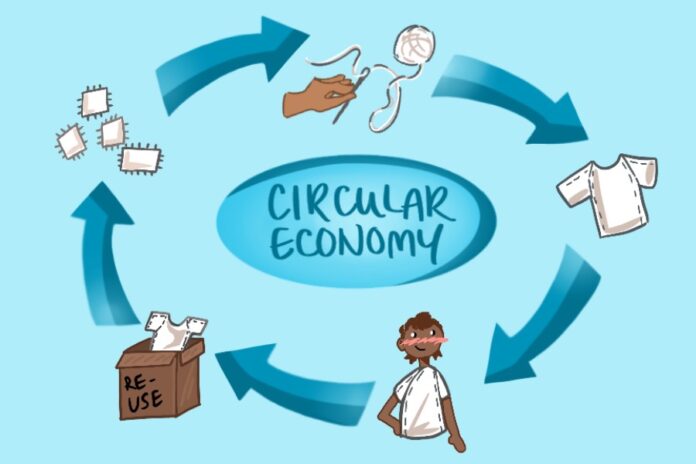How donating and reusing can create a more sustainable way of living
By MAYA KORNYEYEVA — mkornyeyeva@ucdavis.edu
In the United States alone, an estimated 11.3 million tons of textile waste — 85% of all textiles — fills up landfills each year, along with 40% of all food produced. Each person on the planet accounts for roughly 1.2 tons of single-use plastic waste annually, and the situation is only getting worse: an alarming trend shows a rise in global waste by 70% in 2050 due partially to population growth and urbanization but also to the apathy that a majority of us exhibit towards our planet and resources.
Over the last century, the U.S. and many other nations have adopted an economic model that revolves around linear product development, otherwise known as “cradle to grave.” In the cradle, natural resources like precious metals, fossil fuels and organic materials are harvested from the earth and transformed via numerous manufacturing processes to be made available for use. After the product is no longer needed — or its functionality has been exhausted — most people toss it in the trash and forget about it. This is when the product arrives at its grave: a landfill somewhere remote where it can rest for potentially thousands of years before degrading.
In recent years, a new economic concept has been bounced back and forth between lawmakers and activists; namely, the idea of a circular economy.
In a circular economy, the product follows a path from “cradle to cradle,” and never reaches a definitive “grave.” Instead, after it is no longer useful in its original form, it can be recycled and disassembled for reuse as a new product. While this method requires substantially more responsibility on the part of governments, companies and the public, the benefits are well worth it.
For one, a circular approach to product development would mean a reduction in the money that is wasted on products that will never hit consumer homes. According to the environmental news and data platform Earth.org, $500 billion is lost each year due to under-wearing and failure to recycle clothes. If hundreds of billions of dollars go down the drain and disappear on just textiles, how much more money is simply vanishing when we direct our attention to electronic or food waste? With this in mind, repurposing used materials can essentially put money back into the manufacturer’s pocket and prevent over-extraction of limited natural resources.
Recycling can also save space. Rather than sending millions of laptops or flatscreen TVs to the landfill, the plastic, metals and glass can be removed and the rest of the materials melted down, leaving the environment cleaner and less polluted as a result.
Donating, just like recycling, can also incentivize companies to cut back on new product manufacturing, thereby minimizing the need for excessive or wasteful material.
The beauty of donation is that a product can be immediately reused by someone who truly needs it, especially when they are already faced with few affordable options. Donating also ensures that nothing goes to waste and that an item unnecessary to one person can make a big difference for someone else.
UC Davis has a lot of organizations that ensure our college campus is sustainable. One example is the Aggie Reuse Store, an on-campus thrift store that has a number of items available for students at no cost. At this ASUCD unit, you can bring in a sweater you no longer need and find a new T-shirt for yourself instead, or donate some accessories or school supplies. In this way, the Aggie Reuse Store promotes creative upcycling and a consistent flow of products for those in need.
Aggie Compass is another on-campus organization that provides students with zero-cost supplies and basic needs, including groceries and hygienic products. One of the services offered by Aggie Compass is the ASUCD Pantry in the Memorial Union, where students can find grocery items from bagels to orange juice to potatoes at no cost.
These initiatives are exactly what institutions and communities should pursue, for the sake of securing a way of living that is minimally wasteful and thereby protecting our collective future. We need to collectively alter our behavior to incentivize donating, reusing and repurposing household items to minimize global pollution and protect our environmental resources.
Contrary to the common misconception, we do not have an infinite supply of raw materials to utilize for the creation of an infinite amount of things. There are limits, and we must respect those limits and think of the future rather than brush off the inevitable build-up of waste caused by rampant overconsumption.
Written by: Maya Kornyeyeva — mkornyeyeva@ucdavis.edu
Disclaimer: The views and opinions expressed by individual columnists belong to the columnists alone and do not necessarily indicate the views and opinions held by The California Aggie.





